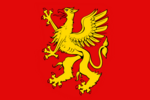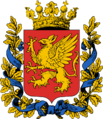Coat of arms of Elstock
| Coat of arms of Elstock | |
|---|---|
 | |
| Versions | |
 The banner of arms, which serves as state flag | |
| Adopted | 23 October 1914 |
| Blazon | Gules, a griffin rampant Or |
The coat of arms of the Free City of Elstock (Elsian: herb Wòlnégò Garda Elstók; Tyrnican: Wappen der Freien Stadt Elstock) depicts a red shield charged with a gold griffin, officially described as Gules, a griffin rampant Or. The coat of arms has officially represented the Free City of Elstock since its adoption in 1937, and unofficially since at earliest the 13th century.
History
The coat of arms first appeared in Elstock in the mid-13th century, shortly after the city's annexation and Perendization by the Order of Saint Perende. The colours red and gold are assumed to be either derived from or influenced by the order's banner of a gold cross on a red field, although debate remains on the authenticity of this theory. The symbol of a griffin as a powerful mythological beast of both land and sea may denotes Elstock's position as a coastal city, and has since the 19th century has been associated with the wider Elsian ethnic community at large.
Although the coat of arms has been associated with Elstock since the High Middle Ages, appearing on stamps, documentation, and buildings, it was only in 1937 that the city officially adopted the symbol as its official coat of arms. This legality was updated in 1999 with Elstock's independence, with the coat of arms serving as the sole coat of arms for the Free City since 1 January 2000.
Use
The coat of arms in a modern context primarily are used by the government of the Free City, and appear on official documents, communiques, and government buildings. It also appears on buildings hosting Elstock's foreign missions, and as a fabric badge on the uniforms of the city-state's police force. The coat of arms also appear in a unofficial context, namely at celebrations and festivals, such as the Elstock Regatta.





